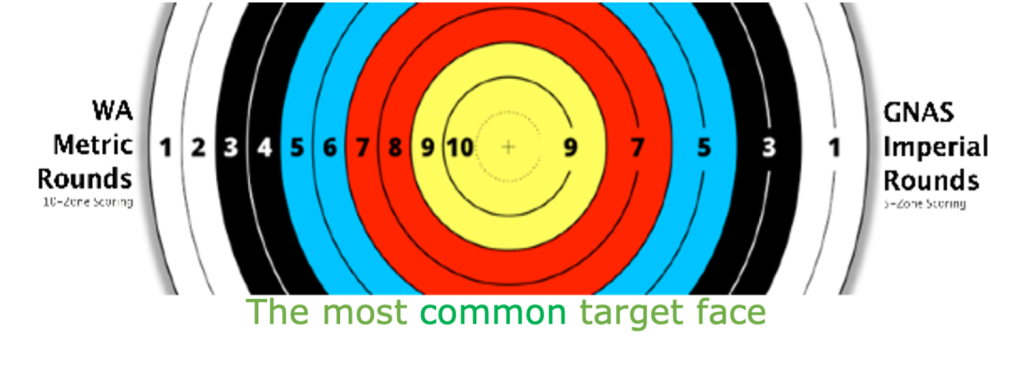Scoring may appear complex at first but is based on simple rules. If you are not sure, please don’t hesitate to ask any of the experienced archers. We’ve all been there.
The yellow, red, blue, black & white target face is the most common and comes in various sizes for different rounds:
- 122cm - Outdoors
- 80cm - Outdoors
- 60cm - Indoors
- 40cm - Indoors
A ‘round’ refers to any named shoot, such as a Portsmouth or a Bristol.
There are two main types of target archery round, imperial and metric, and they use two different scoring methods:
- GNAS imperial, 5 zone scoring, shown on the right, and
- WA metric, 10-zone scoring, shown on the left
When scoring a 10-zone round, all values from 10 to 1 are scored. When scoring a 5-zone round, you score only the odd numbers: 9, 7, 5, 3, 1.

The most popular round in the UK is the Portsmouth, an indoor round shot on a 60cm face from the 20 yards line and scored using 10 zone scoring.
The most popular round internationally is the WA18, an indoor round shot on a 40cm face from the 18 metres line and scored using 10 zone scoring.
The Field Captain will explain the scoring before shooting begins, but if there is anything that you do not understand, please don’t hesitate to ask.
Whoever is shooting on position ‘C’ on the scoresheet is normally appointed as the Target Captain and is responsible for recording the scores on the scoresheet.
Never touch any of the arrows or the target face until all arrows have been scored and recorded on the scoresheet, and the Target Captain says “OK to pull”.
If an arrow touches a line, this is called a ‘line cutter’ and you may claim the higher points value.
When you call your scores to the Target Captain, call them in groups of 3 in descending value, e.g.
“8 7 6 ... 5 4 Miss”.
It is good practice to leave a short pause between two groups of three scores to give the Target Captain time to repeat them as they are entered on the scoresheet.
Competitions are mostly shot in 3s.
It is up to every archer on your target to listen to the scores being called and to challenge them if necessary. If you think another archer’s arrow is a line cutter, suggest they may score the higher value.